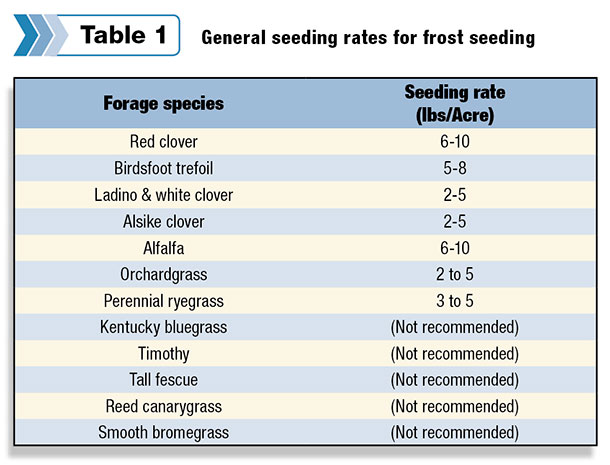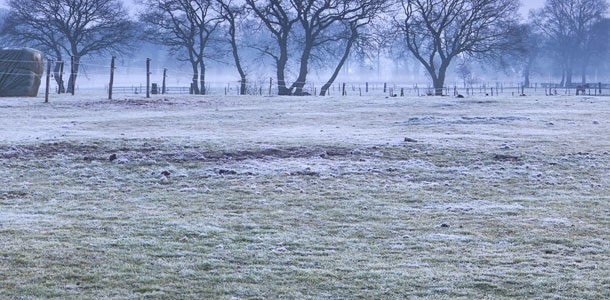Frost seeding is simply broadcasting legume or grass seed on existing grass pastures in late winter or very early spring when the ground is still frozen. Freezing and thawing, plus early spring rains, provide the only seed coverage.
Forage producers have long used frost seeding as an effective means to improve pasture yields or change forage composition, and there are steps that can increase success.
Site selection
Thinning grass stands have been a preferred site to use frost seeding. The pasture or hayfield should be closely grazed or clipped in the fall or winter to open the stand and expose soil. A chain drag or light disking can also be used to help open the stand. This will increase the opportunity for seed-to-soil contact.
Soil fertility
Proper soil pH and fertility are essential for efficient forage production. Soil tests should be taken. For optimum production, soil pH should be maintained above 6. Regardless of the seeding method used, corrective applications of phosphorus and potassium should be applied prior to seeding.
Species selection
Most frost seedings introduce or increase a forage legume species into an established grass stand. The producer needs to select the legume best suited to the soil conditions and its intended use.
Forage quality is improved when legumes are added to grass stands. Quality improvement is seen in increased palatability, intake, digestibility and nutrient content. Research has proven that legumes will improve animal growth rates, milk production and reproductive efficiency.
Red clover
Red clover has widely been accepted as the legume of choice for frost seeding. Red clover has high seedling vigor and is somewhat tolerant of a wide range of conditions relating to pH and fertility, drainage and drought. Red clover stands generally last two years.
Birdsfoot trefoil
Birdsfoot trefoil is slow to establish but is bloat-free and, when established, does well in a wide range of conditions. A mixture of trefoil with red clover may be desirable.
Red clover establishes quickly and produces well for one or two years, while trefoil stands improve with time and become the dominant legume as red clover dies out.
White and ladino clover
White and ladino clover will last somewhat longer than red clover but are less tolerant of low fertility, drought and overgrazing. Ladino and white clover stands may last three years or more.
Alfalfa
Alfalfa should be established on soils that are well drained, near neutral in pH and adequately fertilized with phosphorus and potassium. In optimum conditions, yields and quality are high and stands may last four years or more of rotational grazing.
Regardless of the species, all seedings should be made with high-quality, improved-variety seed. While frost seeding is an economical practice, there is no justification to use low-quality seed. The economics will be in favor of high-quality, improved-variety seed when you consider the entire lifetime of a stand.
Grasses do not establish with the same level of success as legumes. Broadcasting grass seed can present some problems when mixed with legume seed, as the grass seed will not spread as far.
Therefore, it is recommended that grasses be seeded separately from legumes when using a broadcast seeder. Perennial ryegrass and orchardgrass exhibited the best establishment success, while reed canarygrass and timothy had the least success.
Minimal success rates overall have been reported with attempts to add grasses to established grass stands through frost seeding and is generally not recommended.
Seeding time and method

The basic principle behind frost seeding is the “honeycombing” action created by alternating freezing and thawing cycles in late winter. This activity helps to incorporate broadcast seed into the soil surface.
To take advantage of these environmental changes, frost seeding should occur in late February or March. Seeding should be done when the ground is still frozen. The probability of success decreases with the onset of spring due to higher surface soil temperatures and lower moisture.
Seed can be distributed by broadcast seeders, either tractor-mounted or ATV-mounted, hand-held or mixed with fertilizer and applied. It is optimal to broadcast seed early in the spring after the snow is gone but while the ground is still frozen.
Frost seeding on top of snow, especially with fertilizer, is not recommended because rapid snow melting may cause the seed to be washed off the pasture.
Post-seeding management
Control of grass and weed competition during the first two or three months of the growing season is critical for the establishment of adequate legume stands. Use moderate periodic grazing after the grass starts growing, but avoid close grazing.
Some mowing may be necessary to help control grass and weeds. After the seeding year, maintain fertility and manage grazing to encourage a productive and long-lived forage stand.
Frost seeding can be an effective, economical means of introducing a new forage species or to maintain the current composition of a pasture or hayfield. Frost seeding is frequently implemented where tillage is not a viable option because of erosion concerns.
Desired results can be obtained when attention is paid to site selection, fertility, species selection, seeding rates, seeding times and method, and post-seeding management. FG
PHOTO
Photo courtesy of Thinkstock













